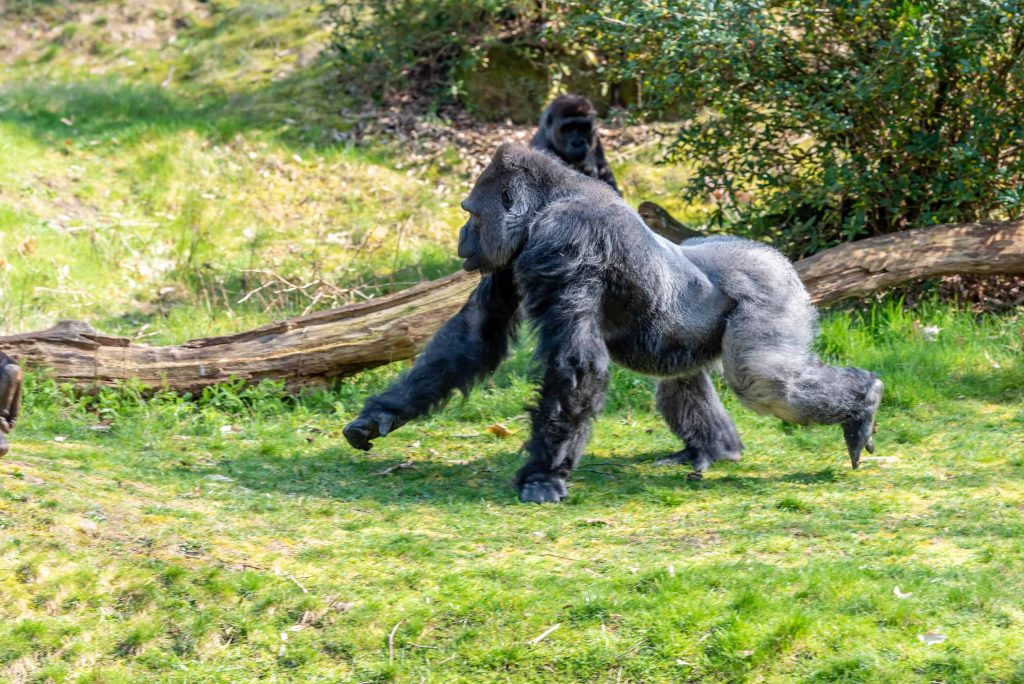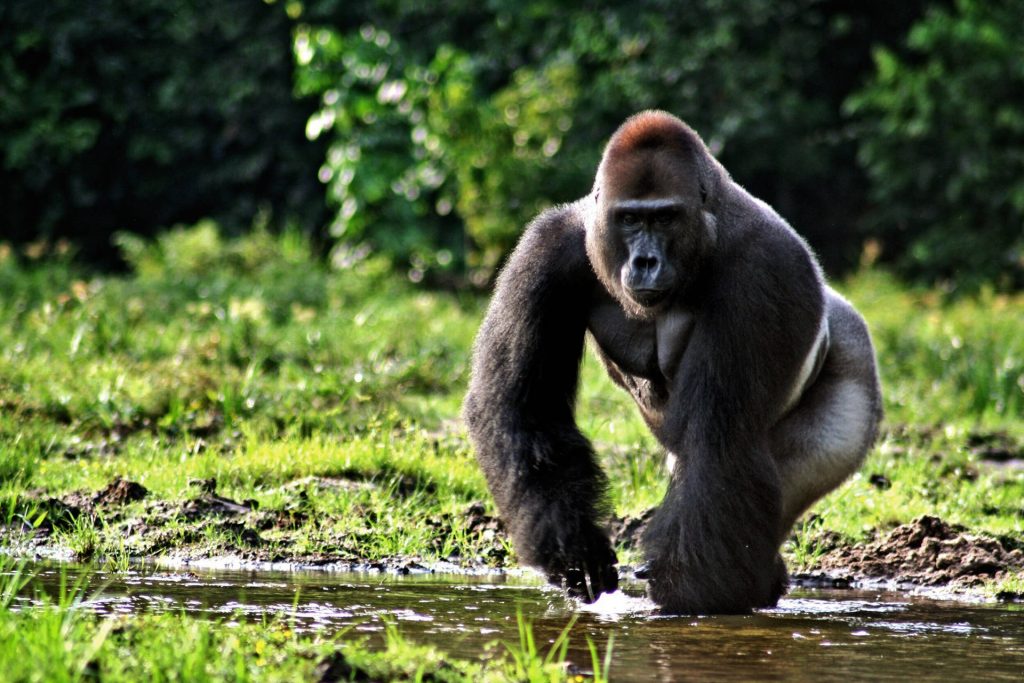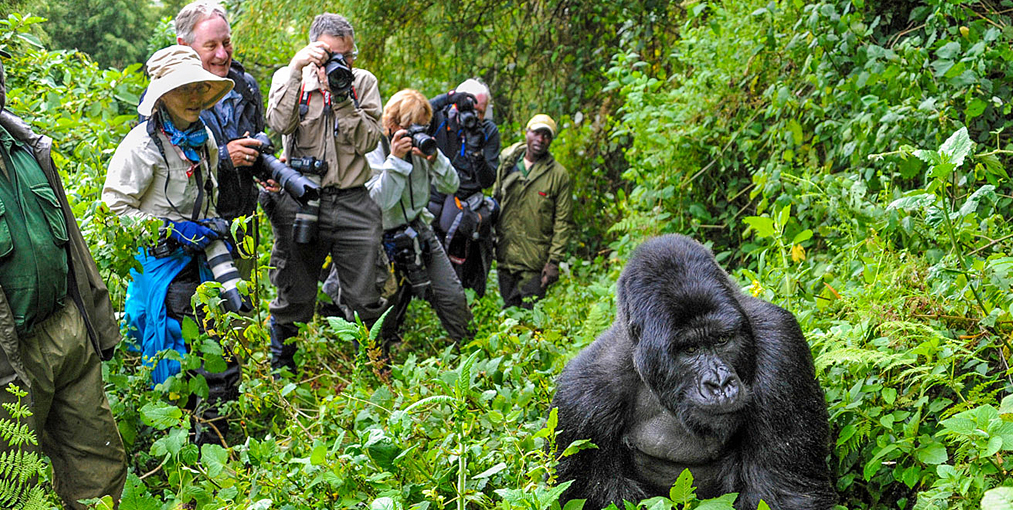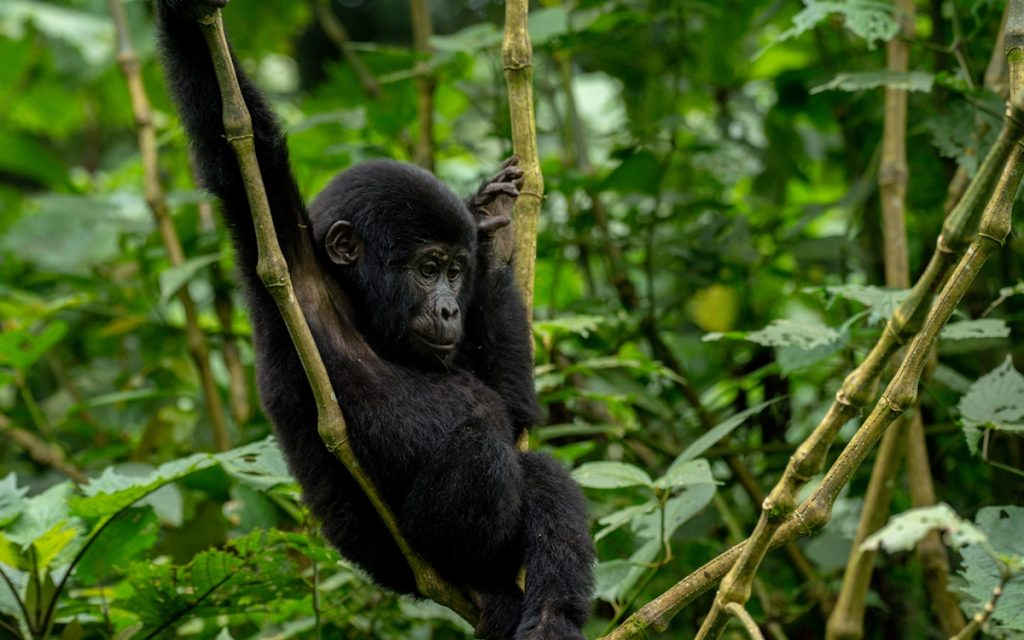- Written by: Anthony
- May 15, 2025
How fast can a gorilla run?
How fast can a gorilla run?
When you think of gorillas, the imagination that often comes to your mind is that of a slow, clumsy giant, usually chewing on leaves and basking in the forest. But behind their calm, bulky body build lies a surprising burst of speed.
Yes, picture a mountain slope in Bwindi’s mist. A silverback, calm one moment, suddenly wheels around—four limbs biting into the earth, shoulders rippling like taut ropes.
That rare glimpse brings the question that echoes in many trekkers’ minds: how fast can a gorilla run?
Gorillas normally prefer a slower and short sprint reaching about 40 kilometers per hour—close to the top speed of a recreational motor scooter and only a shade behind Usain Bolt’s Olympic peak.
Keep in mind: that the longest gorilla burst lasts seconds not even minutes.
Gorillas are sprinters, not marathoners, trading endurance for a sudden shock of momentum that clears obstacles and intimidates rivals before a confrontation ever happens.
Suggested Safari Itineraries
5-Day Kahuzi Biega Congo Gorilla Trekking & Chimp Safari in Rwanda
$ 2500
per personHow Fast Can They Really Run?
Gorillas can sprint at speeds of up to 40 km/h (25 mph).
Imagine a giant weighing between 136 to 227 kg (300 to 500 lbs) coming towards you at that speed — it’s a sight to behold.
This kind of explosive power is particularly remarkable given that gorillas are not built like cheetahs or lions. They are solid, muscular, and heavy, yet capable of moving at speeds comparable to that of a trained human sprinter. This is amazing, isn’t it?
 Why Do Gorillas Run?
Why Do Gorillas Run?
While gorillas aren’t known for chasing down prey, they may be seen running for specific reasons.
- One primary reason is to assert dominance or display aggression. When a gorilla (especially a silverback) perceives a threat, it may charge forward at full speed in a display of power, arrogance with a particular aim of intimidating rather than attackking. This is called a bluff charge — a tactic used to scare away intruders or rival males.
- Running also serves a defensive purpose. Although they are immensely strong, gorillas can still be vulnerable to certain predators, like leopards, or to human threats. In such cases, running becomes a way to escape danger or guide their family to safety.
How Do Gorillas Run?
Unlike most animals that sprint upright or on four legs, gorillas have a unique running style known as knuckle-walking. This involves moving on all fours while balancing their weight on their knuckles and feet. When running at full speed, they lean forward, using both their powerful arms and legs to propel themselves forward in powerful bursts.
Despite their large size, gorillas are incredibly agile. Their long arms and strong legs allow them to navigate through dense forests quickly, making them surprisingly adept at manoeuvring through rough terrain.

Silverback gorilla Knuckle-walking (Image from istock)
Gorillas are built for raw power, not distance
When it comes to gorillas, they have built muscles over mileage. A silverback may weigh 180-200 kg, most of it lean mass concentrated across chest and arms. Those proportions generate immense torque for climbing and wrestling but burn oxygen quickly.
Knuckle-walking leverage. Running on all fours lets gorillas launch with arm strength equal to leg drive. The long forelimbs plant first, vaulting the body forward like a living catapult.
Flexible spines. Though they seem barrel-chested, gorillas flex at the waist with surprising range, allowing sudden directional changes in dense forest where a straight sprint would end against a trunk.
Recommended Safaris
Gorilla speed compared to other animals
While 40 km/h (25 mph) might not seem particularly fast compared to a cheetah’s top speed of 112 km/h (70 mph), it is still impressive considering their body structure. In comparison:
- A trained sprinter peaks near 45 km/h for fractions of a second; most healthy adults top out under 24 km/h.
- Predators. Leopards clock roughly 58 km/h but rely on stealth, not pursuit. Lions can burst past 80 km/h over open savanna—far faster but in terrain gorillas seldom enter.
- Other great apes. Chimpanzees sprint near 35 km/h, slightly slower but more agile in the canopy. Orangutans seldom dash; they swing.
In essence, while gorillas aren’t the fastest animals in the jungle, they more than make up for it with raw power and incredible strength. In a sprinting contest, they might not win against a lion or a cheetah, but they can certainly outrun most humans.
What this means for trekkers
If you meet gorillas on foot in Uganda’s Bwindi or Rwanda’s Volcanoes National Park, keep the recommended seven-metre buffer. A guide’s soft grunt calms the troop; your stillness signals respect. Remember, every measured breath you take is a reminder that their sprint eclipses yours. The best view comes not from closing the gap but from waiting, heart thundering, until a curious youngster ambles closer on gorilla terms.
Conclusion
So, how fast can gorillas run? At 40 km/h (25 mph), they’re faster than the average human and capable of powerful, short bursts of speed that can leave a lasting impression. Whether they’re bluff charging a rival or making a quick getaway, gorillas use their speed strategically — not to hunt, but to defend and assert dominance.
Cheetahs claim outright velocity, antelopes claim stamina, but gorillas embody controlled power—an athlete who sprints only when necessary, then settles back into the forest’s hush.
Next time you picture a gorilla, remember that beneath that calm, massive frame is a powerhouse capable of an unexpected, breathtaking sprint.
Anthony

Ready for your ultimate wildlife experience?
Chat with us, our team is always here to help!
You may also like …

Got any questions
about traveling to Uganda?
Get in touch.








